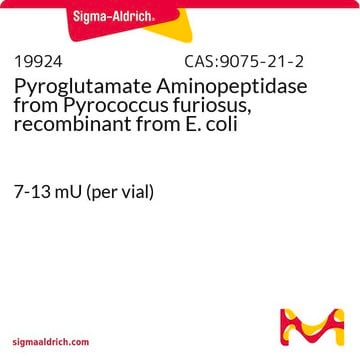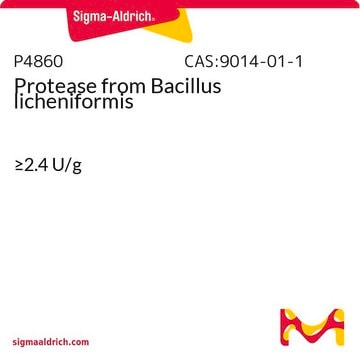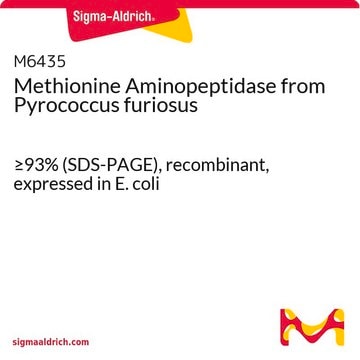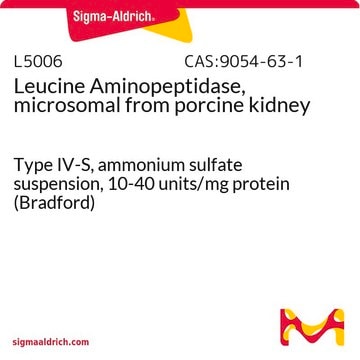P6236
Pyroglutamate Aminopeptidase from Pyrococcus furiosus
recombinant, expressed in E. coli, ~90% (SDS-PAGE), ≥5.0 units/mg protein
Synonym(s):
L-Pyrrolidone carboxyl peptidase
Sign Into View Organizational & Contract Pricing
All Photos(1)
About This Item
EC Number:
MDL number:
UNSPSC Code:
12352204
NACRES:
NA.54
Recommended Products
General description
Pyroglutamate Aminopeptidase from Pyrococcus furiosus, also called the deblocking aminopeptidase, is a 42 kDa protein and belongs to aminopeptidase A family. It shares sequence homology with aminopeptidase in the active site, with conserved zinc and cobalt binding residues.
Application
Pyroglutamate Aminopeptidase, from Pyrococcus furiosus is a recombinant, thermostable aminopeptidase that is expressed in Escherichia coli. It is used to cleave pyroglutamic acid which allows analysis of N-terminal sequences of peptides.
The enzyme from Sigma has been used for the removal of pyroglutamate (pGlu) N-terminal blocking group, under reduced conditions, prior to N-terminal sequencing of purified cassiicolin.
Thermostable aminopeptidase that liberates N-terminal pyroglutamic acid from proteins and peptides prior to Edman degradation.
Biochem/physiol Actions
Pyroglutamate Aminopeptidase (PGP 1) interacts with immunoglobulin, functions as inflammatory cytokine and modulates immune response. The levels PGP 1 is elevated during inflammation.
This enzyme is specific for N-terminal pyroglutamic acids. It cleaves the N-terminal pyroglutamic acid from proteins and peptides prior to Edman degradation. The optimal temperature range is 95 to 100 °C and the optimal pH range is 6.0 to 9.0.
Unit Definition
One unit will hydrolyze 1 μmol of pyroglutamate p-nitroanilide per minute at pH 7.0 at 37 °C.
Physical form
Lyophilized powder containing sodium phosphate
Preparation Note
Reconstitute the vial of enzyme with 50 μl of 50 mM sodium phosphate, pH 7.0, with 10 mM DTT and 1 mM EDTA. The reconstituted solution should be stored at -20 °C.
Signal Word
Danger
Hazard Statements
Precautionary Statements
Hazard Classifications
Eye Irrit. 2 - Resp. Sens. 1 - Skin Irrit. 2 - STOT SE 3
Target Organs
Respiratory system
Storage Class Code
11 - Combustible Solids
WGK
WGK 3
Flash Point(F)
Not applicable
Flash Point(C)
Not applicable
Personal Protective Equipment
dust mask type N95 (US), Eyeshields, Gloves
Certificates of Analysis (COA)
Search for Certificates of Analysis (COA) by entering the products Lot/Batch Number. Lot and Batch Numbers can be found on a product’s label following the words ‘Lot’ or ‘Batch’.
Already Own This Product?
Find documentation for the products that you have recently purchased in the Document Library.
Customers Also Viewed
A Ultrasensitive Near-Infrared Fluorescent Probe Reveals Pyroglutamate Aminopeptidase 1 Can Be a New Inflammatory Cytokine
Gong Q, et al.
Advanced science (Weinheim, Baden-Wurttemberg, Germany), 5(4), 1700664-1700664 (2018)
Pyroglutamate aminopeptidase 1 may be an indicator of cellular inflammatory response as revealed using a sensitive long-wavelength fluorescent probe
Gong Q, et al.
Chemical Science, 7(7), 4694-4697 (2016)
New deblocking aminopeptidases from Pyrococcus horikoshii
Mori K and Ishikawa K
Bioscience, Biotechnology, and Biochemistry, 69(10), 1854-1860 (2005)
Frédéric de Lamotte et al.
Journal of chromatography. B, Analytical technologies in the biomedical and life sciences, 849(1-2), 357-362 (2006-11-23)
Cassiicolin, a phytotoxin produced by the necrotrophic fungus Corynespora cassiicola, was purified to homogeneity from a rubber tree isolate. The optimized protocol involves reverse phase chromatography followed by size exclusion chromatography, with monitoring of the toxicity on detached rubber tree
Gorka Larrinaga et al.
Neuroscience letters, 383(1-2), 136-140 (2005-06-07)
We evaluated the subcellular distribution of four membrane-bound aminopeptidases in the human and rat brain cortex. The particulate enzymes under study--puromycin-sensitive aminopeptidase (PSA), aminopeptidase N (APN), pyroglutamyl-peptidase I (PG I) and aspartyl-aminopeptidase (Asp-AP)--were fluorometrically measured using beta-naphthylamide derivatives. Membrane-bound aminopeptidase
Our team of scientists has experience in all areas of research including Life Science, Material Science, Chemical Synthesis, Chromatography, Analytical and many others.
Contact Technical Service











